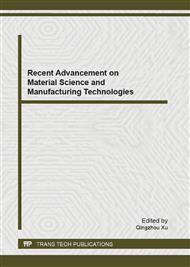[1]
X.G.. Zhang. Corrosion and Electrochemistry of Zinc, Plenum Publishers, New York (1996).
Google Scholar
[2]
X.G.. Zhang. J. Power Sources 163 (2006) 591-597
Google Scholar
[3]
R.M. Dell. Solid State Ionics 134 (2000) 139-158
Google Scholar
[4]
McLarnon, F. R., and Cairns, E.J.: The secondary alkaline zinc electrode, J. Electrochem. Soc. 138, 645-664, 1991.
DOI: 10.1149/1.2085653
Google Scholar
[5]
McBreen, J., and Cairns, E.J.: The zinc electrode, in Advances in Electrochemistry and Electrochemical Engineering, Vol. 11, H. Gerischer and C. W. Tobias(eds.), pp.273-352, John Wiley & sons, New York, 1978.
Google Scholar
[6]
Gouda, K. K., Khedr, M. G. A., and Shams EI Din, A. M.: Role of anions in the corrosion and corrosion-inhibition of zinc in aqueous solutions, Corros. Sci.7, 221-230, (1967)
DOI: 10.1016/s0010-938x(67)80084-2
Google Scholar
[7]
Kordesch, K. V.: Alkaline manganese dioxide zinc batteries, in Batteries, K. V. Kordesch (ed), Vol.1, pp.241-384, Marcel Dekker, New York, (1974)
DOI: 10.1007/978-1-4615-6687-8_6
Google Scholar
[8]
Brodd, R. J.: Batteries for Cordless Appliances, Research Studies Press, Letchworth, England, 1987.
Google Scholar
[9]
Huber, R.: Leclanche batteries, in Batteries, K. V. Kordesch (ed.), Vol. 1, pp.1-239, Marcel Dekker, New York, 1974.
Google Scholar
[10]
A. Renuka, A. Veluchamy, N. Venkatakrishnan, S.N. Begum V.R. Chidambaram, R. Sabapathi, J. Appl. Electrochem. 22 (1992) 182.
DOI: 10.1007/bf01023822
Google Scholar
[11]
E.G. Gagnon, J. Electrochem. Soc. 138 (1991) 3173.
Google Scholar
[12]
J.Y. Huot, M. Malservisi, J. Power Sources 96 (2001) 133.
Google Scholar
[13]
A.P. Pavlov, L.K. Grigorieva, S.P. Chizhik, V.K. Stankov, J. Power Sources 62 (1996) 113.
Google Scholar
[14]
H. Chang, C. Lim, J. Power Sources 66 (1997) 115.
Google Scholar
[15]
L. Telli, A. Hammouche, B. Brahimi, R.W.D. Doncker, J. Power Sources 103 (2002) 201.
Google Scholar
[16]
Y. Shen, K. Kordesch, J. Power Sources 87 (2000) 162.
Google Scholar
[17]
Y. Sharma, M. Aziz, J. Yusof, K. Kordesch, J. Power Sources 94(2001) 129.
Google Scholar
[18]
R.M. Dell, Solid State Ionics 134 (2000) 139.
Google Scholar
[19]
J. Jindra, J. Power Sources 66 (1997) 15.
Google Scholar
[20]
J. Jindra, J. Power Sources 88 (2000) 202.
Google Scholar
[21]
F. Beck, P. Ruetschi, Electrochim. Acta 45 (2000) 2467.
Google Scholar
[22]
A.P. Karpinski, B. Makovetski, S.J. Russell, J.R. Sevenyi, D.C. Williams, J. Power Sources 80 (1999) 53.
Google Scholar
[23]
J. Skelton, R. Serenyi, J. Power Sources 65 (1997) 39.
Google Scholar
[24]
D. Coates, E. Ferreira, A. Charkey, J. Power Sources 65 (1997)109.
Google Scholar
[25]
W.H. Zhu, M.E. Flanzer, B.J. Tatarchuk, J. Power Sources 112 (2002)353.
Google Scholar
[26]
J. Goldstein, I. Brown, B. Koretz, J. Power Sources 80 (1999)171.
Google Scholar
[27]
D.F. Smith, J.A. Gucinski, J. Power Sources 80 (1999) 66.
Google Scholar
[28]
H. Lewis, P. Jackson, A. Salkind, T. Danko, R. Bell, J. Power Sources96 (2001) 128.
Google Scholar
[29]
F.R. Mclarnon, E.J. Cairns, J. Power Sources 138 (1991) 645.
Google Scholar
[30]
W. Glaeser, S.K. Keune, P. Merkel, J. Power Sources 80 (1999)72.
Google Scholar
[31]
M.V. Simicic, K.I. Popov, N.V. Krstajic, J. Electroanal. Chem. 484(2000) 18.
Google Scholar
[32]
A.R.S. Kannan, S. Muralidharan, K.B. Sarangapani, V.Balaramachandran, V. Kapali, J. Power Sources 57 (1995) 93.
DOI: 10.1016/0378-7753(95)02225-2
Google Scholar
[33]
R. Shivkumar, G.P. Kalaignan, T. Vasudevan, J. Power Sources 55(1995) 53.
Google Scholar
[34]
R. Shivkumar, G.P. Kalaignan, T. Vasudevan, J. Power Sources 75(1998) 90.
Google Scholar
[35]
J.M. Wang, L. Zhang, C. Zhang, J.Q. Zhang, J. Power Sources 102(2001) 139.
Google Scholar
[36]
J.L. Zhu, Y.H. Zhou, H. Yang, J. Power Sources 69 (1997) 169.
Google Scholar
[37]
Grzegorz Wnuk, Jolanta Romanowska, Tadeusz Pomianek. J. Chem. Thermodynamics35 (2003) 711–717
Google Scholar
[38]
A. G. Munoz, S.B. Saidman, J.B. Bessone. Corrosion Science 43(2001)1245-1265
Google Scholar
[39]
M. Yano, S. Fujitani, K. Nishio, Y. Akai, M. Kurimura. Journal of Power Sources 74(1998) 129-134.
DOI: 10.1016/s0378-7753(98)00044-5
Google Scholar
[40]
Jean-Yves Huot, Emmanuelle Boubour. Journal of Power Sources 65(1997)81-85.
Google Scholar
[41]
Bocchi, N., da Cunha, M. R., and D, Alkaline, C.V.: The passivating films of zinc in alkaline solution, Key Eng. Mater. 20-28(1988)3941-3946.
DOI: 10.4028/www.scientific.net/kem.20-28.3941
Google Scholar
[42]
Chang, Y., and Prentice, G.: A model for the anodic dissolution of the zinc electrode in the prepassive region, J. Electrochem. Soc. 136(1989)3398-3403.
DOI: 10.1149/1.2096460
Google Scholar
[43]
Dirkse, T. P.: Voltage decay at passivated zinc anodes, J. Appl. Electrochem. 1(1971)27-33.
DOI: 10.1007/bf00615743
Google Scholar
[44]
Hull, M. N., Ellison, J. Electrochem. Soc. 117(1970)192-198.
Google Scholar
[45]
Sato, Y., Niki, H., and Takamura, T.: Effects of carbonate on the anodic dissolution and the passivation of zinc electrode in concentrated solution of potassium hydroxide, J. Electrochem. Soc. 118 (1971) 1269-1272.
DOI: 10.1149/1.2408303
Google Scholar
[46]
Huang Qi-ming,Li Wei-shan,Zhang Shi-yong,et al. Application of indium in mercury-free alkaline Zn/MnO2 batteries. BATTERY BIMONTHLY, 2001,31(5):233-235
Google Scholar
[47]
Shi Jian-zhen,Gao Cui-qin,Zhu Ji-ling,et al. The effects of metals on the electrochemical behavior of Zn electrode. Chinese Journal of Power Sources, 1997, 21(1): 3-7
Google Scholar
[48]
Dirkse, T. P., and Hampson, N. A.: The anodic behaviour of zinc in aqueous KOHsolution. Part Ⅰ. Passivation experiments at very high current densities, Electrochim. Acta 16(1971) 2049-2056.
DOI: 10.1016/0013-4686(71)85018-1
Google Scholar
[49]
Passivity and passivity breakdown of a zinc electrode in aerated neutral sodium nitrate solutions. Electrochimica Acta 50 (2005) 1265-1274
DOI: 10.1016/j.electacta.2004.07.051
Google Scholar
[50]
Liu, M., Cook, G. M., and Yao, N.P.: Passivation of zinc anodes in KOH electrolytes, J. Electrochem. Soc. 128 (1981)1663-1668.
DOI: 10.1149/1.2127707
Google Scholar
[51]
G. Wilcox and P. Mitchell. J. Power Sources, 28, 345 (1989).
Google Scholar


